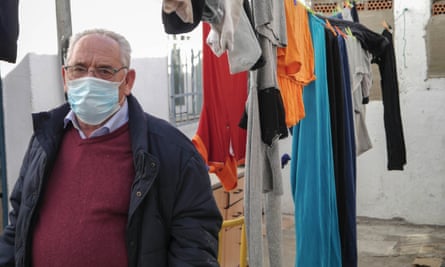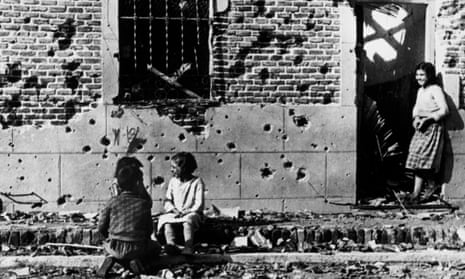Jesús Rico sits outside the tiny, damp Madrid apartment he and his family are about to leave after nine airless summers and nine punishing winters, and ponders their debt to a long-dead Hungarian-American photojournalist.
“If the Capa picture hadn’t happened,” says Rico, “we’d have been out on the street.”
On his second trip to Spain towards the end of 1936, the war photographer Robert Capa came across a bomb-damaged house in the working-class Madrid neighbourhood of Vallecas.
The roof and facade of 10 Peironcely Street had been gouged by shrapnel from the bombs dropped by the German planes that Hitler dispatched to support General Franco’s coup, and the street outside was thick with debris.
But there were also glints of joy amid the rubble, and the picture Capa took that day shows three children playing happily on the pavement under the equally beaming gaze of a woman.
Capa’s image, which appeared in the US, Swiss and French press, offered proof of the civilian cost of the nascent Spanish civil war months before the bombing of Guernica.

The photograph has also enjoyed a remarkable afterlife in the 11 years since it was matched to its location, a modest brick block that has somehow survived Nazi bombs and decades of rampant redevelopment in the capital.
As the house’s fame grew, so did concern about the miserable conditions in which its latter-day tenants were living. In the summer of 2017, a campaign was launched to save the building and rehouse the families squeezed into its 15 flats, some of which measured just 17 sq metres.
Last month, Madrid city council finally made good on its promise to expropriate the building, and by the end of Monday all of its 13 tenant families will have been rehoused in larger, newly built flats.
“I don’t have the words to describe what the move means to us: they’re giving us space, and space to us is life,” says Rico. “I feel like I’ve won the lottery; I never need to win anything else in life.”
Juan Nolasco, a retired builder, has spent the past six years living in a flat whose hallway-cum-kitchen is so narrow that you have to turn sideways to pass between the units and the extractor hood on the opposite wall. What little light there is comes from the flat’s only window, which looks out on to a patio, now suddenly crowded with suitcases, white goods, and the odd TV crew dispatched to document the occasion.
“We needed help and we needed somewhere better to live,” says the 71- year-old, who is looking forward to moving into his new place. “I’ll miss the neighbours but the friendships will go on.”

Despite itching to get out of the 24 sq metre flat in which he lives with his wife, two of their children and one of their grandchildren, Rico will also miss the sense of community and camaraderie.
In the summer, the residents of No 10 put out a paddling pool for the children and congregate in its two patios to chat and escape the heat of their homes. The tenants, many of whom are unemployed or on minimum basic income, have always looked out for one another when times are tight.
“If anyone’s short of money and can’t buy food, there’s always a neighbour with a sandwich, a tupper of something or a plate of chickpeas,” says Rico. “We’ve never let each other go without.”
As each family moves out, workmen come in to board up the flats and brick up their windows so the building can be mothballed while it awaits its next chapter.
Almost three years ago, the city council approved a motion to convert the building into “the Robert Capa centre for the interpretation of the aerial bombing of Madrid”.
“Its use as a cultural centre is guaranteed, and it won’t be knocked down,” says Mar Espinar, a Socialist party councillor and one of the members of the Save Peironcely 10 group.
“We’re very clear that we want it to be a cultural and memory space where people can come and learn about the bombing of Madrid and, in particular, the bombing of the Puente de Vallecas neighbourhood.”
But, given Spain’s ongoing culture wars and enduring divisions over how best to deal with the civil war and its legacy, Espinar predicts another lengthy struggle.
“The museum of memory that we want to see really shouldn’t be a problem for anyone with any common sense,” she says. “It’s not about sectarianism or a particular point of view: it’s about how people lived in those years, how they were affected by the bombing, and how it was captured by Robert Capa.”
For Cynthia Young, former curator of the Robert Capa Archive at the International Center of Photography in New York, the picture’s lasting power lies in its simple juxtaposition. “You see the disasters of war but the sun comes out and these children persevere and live their lives,” she says. “That’s obviously what the editors saw, too, and something that we, as today’s viewers, can also recognise.”

Young views the image as proof of Capa and his colleagues’ commitment to social change, and as an example of how a photograph can exist as far more than just a frozen fragment of news.
“[The photojournalists] do their part but they can’t always control that; you don’t know how history will unfold,” she says. “Other people take up the mantle and use those photographs to really make that difference.”
Few have taken up that mantle quite as enthusiastically and effectively as José María Uría of the trade union Fundación Anastasio de Gracia, who has coordinated the group’s efforts to save the building, prevent the eviction of its tenants and get them rehoused.
The story of 10 Peironcely street, he says, has finally come to “a beautiful conclusion” thanks to Capa, his Leica and a picture that can still pique interest and prick consciences almost 85 years after it was taken.
“But it’s shameful for Spain that all this happened because of that and not because there are laws and a system in place to help people and give them equal opportunities,” says Uría.
“If it wasn’t for that picture, they would have been forgotten. One of the neighbours always used to say something that was pretty bleak but completely accurate: ‘If Capa hadn’t stopped by here, then I’d be in the shit.’”
There are, as Uría points out, “a lot more Peironcelys in Madrid and in Spain, and there are a lot of children living in them without anything as basic as a bathtub. We, as a society, need to have a think about that. We can’t leave it all to photos and random luck.”
